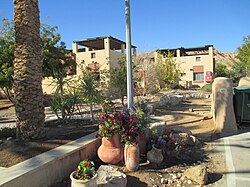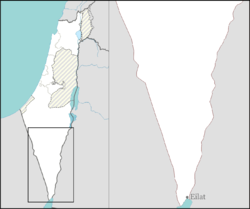Ketura, Israel
Ketura
| |
|---|---|
 | |
| Coordinates: 29°58′3.36″N 35°4′15.24″E / 29.9676000°N 35.0709000°E | |
| Country | Israel |
| District | Southern |
| Council | Hevel Eilot |
| Affiliation | Kibbutz Movement |
| Founded | November 1973 |
| Founded by | American immigrants |
| Population (2022)[1] | 509 |
| Website | www.ketura.org.il |
Ketura (Template:Lang-he-n) is a kibbutz in southern Israel. Located north of Eilat in the Arabah valley, it falls under the jurisdiction of Hevel Eilot Regional Council. In 2022 it had a population of 509.[1]
History
Ketura was founded in November 1973 by a group of young Americans, most of them members of the Zionist youth movement Young Judaea.[2] Its name was taken from a nearby hill and wadi, and is also the name of the second wife of Abraham (Genesis 25:1). Difficulties in the early years frustrated many of the inhabitants of the kibbutz, which caused many of the founders to leave. At the same time, more Young Judaeans joined the community, along with a variety of other immigrants as well as Israel Boy and Girl Scouts Federation graduates. Ketura is in the Southern Arava - Hevel Eilot Regional Council.
Today Ketura has about 150 members and several young families who are candidates to become members. During the year there are about 450 people living on Ketura, members and their families, students in the Arava Institute, volunteers from around the world, AICAT students from around the world, NOAM youth Movement members in various programs such as gap year or shnat sherut, and researchers who come to work in regional institutes.
Religious culture
Ketura is unique among kibbutzim for its religious pluralism. Although the kibbutz is not considered a religious kibbutz, Kashrut and Shabbat are observed in the dining room, public areas, and at social and cultural events, and there is a functioning congregation-led egalitarian synagogue. The population of the kibbutz is composed of observant, masorati, and secular members, an unusual situation for a kibbutz. Ketura received the Speaker of the Knesset Prize for religious tolerance as a result of its religious progressiveness.
Economy

Agricultural enterprises of the kibbutz include a date orchard. The kibbutz is most well known for its guest house and educational seminar center — Keren Kolot[3] — and its partnership in the local algae factory, Algatech[4] which processes haematococcus algae through a filtration system in order to extract natural astaxanthin. The extract is then sold around the world as a natural ingredient and pigment for use in cosmetics; and as a nutraceutical. Ketura is also a partner in the Arava Power Company (APC),[5] producing electricity from solar panels. There is one 4.95MW field on the kibbutz, Ketura Sun, with a second 40MW field opened in 2015, then the largest in Israel.[6]
Economic cooperation with other kibbutzim in the area includes a regional date-packing plant, Ardom Computing Services, and Ardag, a large fish hatchery near Eilat. Many members work outside the kibbutz in professional positions such as teachers, physical and occupational therapists, researchers, social workers, and more. Ketura also offers accounting and bookkeeping services, with many members working in these positions. A number of members work in the local NGO - The Arava Institute for Environmental Studies (www.arava.org)
Environmentalism
Ketura is part of the Green Kibbutz movement. In addition to promoting awareness, recycling and opening a second hand store, Ketura planted a community garden and operates a high-tech algae farm.[7]
Members of Ketura founded the Arava Institute for Environmental Studies (AIES), which is located at Ketura. The institute promotes regional environmental cooperation between Israelis, Palestinians and residents of neighbouring Arab countries in environmental matters, with a focus on the desert ecosystem.[8]

The only surviving example of the Judean Date Palm, artificially germinated from 2,000-year-old seeds discovered in archaeological excavations, was planted in Ketura and continues to survive there.
See also
References
- ^ a b "Regional Statistics". Israel Central Bureau of Statistics. Retrieved 21 March 2024.
- ^ Israeli Desert Yields a Harvest of Energy
- ^ http://www.keren-kolot.co.il/Homepage.html
- ^ https://www.algatech.com/
- ^ http://www.aravapower.com/
- ^ Israel's largest solar field begins flowing to the national grid The Jerusalem Post, 29 July 2015
- ^ Kibbutz in Israeli desert turns to solar power
- ^ Kibbutz in Israeli desert turns to solar power
External links
- Official website
- Ketura Kibbutz Program Center
- Hadassah Medical Organization
- Arava Institute for Environmental Studies

